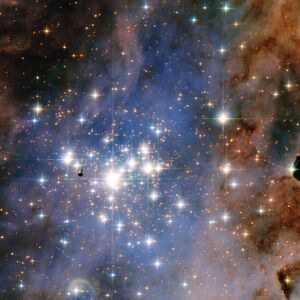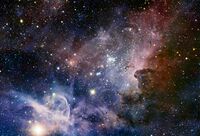Astronomy:Trumpler 14
| Trumpler 14 | |
|---|---|
 | |
| Observation data (J2000 epoch) | |
| Constellation | Carina |
| Right ascension | 10h 43m 56s[1] |
| Declination | −59° 33′ 00″[1] |
| Distance | 8,980 ly (2,753 pc)[1] |
| Apparent magnitude (V) | 5.5[1] |
| Physical characteristics | |
| Mass | 4.3+3.3 −1.5×103 M☉ |
| Estimated age | 300000–500000 years |
| Notable features | One of the youngest known star clusters |
| Other designations | Cr 230, C 1041-593, Cl VDBH 102, [DBS2003] 54, [KPR2004b] 263, [KPS2012] MWSC 1846[1] |
Trumpler 14 (Tr 14) is an open cluster with a diameter of six light-years (1.8 pc), located within the inner regions of the Carina Nebula, approximately 8,980 light-years (2,753 pc) from Earth.[1][2] Together with the nearby Trumpler 16, they are the main clusters of the Carina OB1 stellar association, which is the largest association in the Carina Nebula, although Trumpler 14 is not as massive or as large as Trumpler 16.[3]
About 2000 stars have been identified in Trumpler 14[4] and the total mass of the cluster is estimated to be 4,300 M☉.[5]
Age
It is one of the youngest known star clusters, estimates range from 300 to 500 thousand years old.[5] For comparison, the massive super star cluster R136 is about 1 to 2 million years old,[6] and the famous Pleiades is about 115 million years old.[7]
Members
Due to its location within the inner parts of the Carina Nebula, Trumpler 14 is currently undergoing massive star formation. As a result, the star cluster exhibits many stars of late O to early A spectral type, which are very massive (at least 10 solar masses), short-lived and hot (20000 K). The brightest member is HD 93129, a triple system consisting of three individual class O stars.[8] It also contains HD 93128, an O3.5 V((fc))z star, an extremely hot and young main sequence star.[9]
| Star name | MJ number | Effective temperature | Absolute magnitude | Bolometric magnitude | Mass (M☉) | Spectral type | Ref. |
|---|---|---|---|---|---|---|---|
| HD 93129 | 177 | 42500+44000+44000 | -6.5 + -4.9 | -7.5 | 110+70+52 | O2If+O3.5V+O3.5V((f))z | [10][11][12] |
| HD 93128 | 157 | 51300 | -5.4 | -10 | 75 | O3.5V((fc))z | |
| HD 93160 | 229 | 42700 | -5.9 | -9.9 | 62 | O6III | [13] |
| HD 303311 | 351 | 46100 | -5 | -9.2 | 51 | O5V | [13] |
| CPD-58 2611 | 115 | 43600 | -4.6 | -8.6 | 39 | O6V | [13] |
| HD 305524 | 404 | 39800 | -5 | -8.8 | 37 | [13] | |
| CPD-58 2620 | 192 | 42400 | -4.3 | -8.3 | 35 | O6.5V | [13] |
| 165 | 38500 | -4.8 | -8.5 | 34 | O8V | [13] | |
| HD 305516 | 36 | 43600 | -4 | -8.1 | 33 | [13] | |
| HD 305532 | 593 | 40800 | -4.3 | -8.2 | 33 | [13] | |
| CPD-59 2610 | 449 | 42300 | -4 | -7.9 | 31 | [13] | |
| CPD-58 2627 | 203 | 39800 | -4.1 | -7.9 | 29 | [13] |
Future
In a few million years, as its stars die, it will trigger the formation of metal-rich stars, and in a few hundred million years Trumpler 14 will probably dissipate.[14]
Gallery
-
Image of the Carina OB1 association. Trumpler 14 is the massive cluster of stars at the upper right of center.
-
Trumpler 14 as seen by the Multi-conjugate Adaptive optics Demonstrator (MAD) mounted on ESO's Very Large Telescope (VLT). Image is based on a combination of K and H filters. Field of view is about two arcminutes across.
See also
References
- ↑ 1.0 1.1 1.2 1.3 1.4 1.5 "Trumpler 14". SIMBAD. Centre de données astronomiques de Strasbourg. http://simbad.u-strasbg.fr/simbad/sim-basic?Ident=Trumpler+14.
- ↑ W.S. Dias; B.S. Alessi; A. Moitinho; J.R.D. Lépine (2002). "New catalogue of optically visible open clusters and candidates". Astronomy & Astrophysics 389 (3): 871–873. doi:10.1051/0004-6361:20020668. Bibcode: 2002A&A...389..871D.
- ↑ Davidson, Kris; Humphreys, Roberta M. (23 January 2012). Davidson, Kris; Humphreys, Roberta M.. eds. Eta Carinae and the Supernova Impostors. Astrophysics and Space Science Library, Volume 384. 384. Springer Science+Business Media. doi:10.1007/978-1-4614-2275-4. ISBN 978-1-4614-2274-7. Bibcode: 2012ASSL..384.....D. https://cds.cern.ch/record/1453273.
- ↑ "Young star cluster Trumpler 14 revealed in stunning image". ScienceDaily. 2009-12-04. https://www.sciencedaily.com/releases/2009/12/091203101426.htm.
- ↑ 5.0 5.1 H. Sana; Y. Momany; M. Gieles; G. Carraro et al. (2010). "A MAD view of Trumpler 14". Astronomy & Astrophysics 515: A26. doi:10.1051/0004-6361/200913688. Bibcode: 2010A&A...515A..26S.
- ↑ Crowther, Schnurr; Hirschi, Yusof; Parker, Goodwin; Kassim (2010). "The R136 star cluster hosts several stars whose individual masses greatly exceed the accepted 150 M⊙ stellar mass limit". Monthly Notices of the Royal Astronomical Society 408 (2): 731. doi:10.1111/j.1365-2966.2010.17167.x. Bibcode: 2010MNRAS.408..731C.
- ↑ Basri, Gibor; Marcy, Geoffrey W.; Graham, James R. (1996). "Lithium in Brown Dwarf Candidates: The Mass and Age of the Faintest Pleiades Stars". The Astrophysical Journal 458: 600–609. doi:10.1086/176842. Bibcode: 1996ApJ...458..600B.
- ↑ Kaler, James D. (2002). The Hundred Greatest Stars. Copernicus Books. p. 50. ISBN 978-0-387-95436-3. https://books.google.com/books?id=aJavy9Yk1yoC&pg=PA103. Retrieved 2014-10-01.
- ↑ Smith, Nathan (2006). "A census of the Carina Nebula - I. Cumulative energy input from massive stars". Monthly Notices of the Royal Astronomical Society 367 (2): 763–772. doi:10.1111/j.1365-2966.2006.10007.x. Bibcode: 2006MNRAS.367..763S.
- ↑ Repolust, T.; Puls, J.; Herrero, A. (2004). "Stellar and wind parameters of Galactic O-stars. The influence of line-blocking/blanketing". Astronomy and Astrophysics 415: 349–376. doi:10.1051/0004-6361:20034594. Bibcode: 2004A&A...415..349R.
- ↑ Nelan, Edmund P.; Walborn, Nolan R.; Wallace, Debra J.; Moffat, Anthony F. J.; Makidon, Russell B.; Gies, Douglas R.; Panagia, Nino (2004). "Resolving OB Systems in the Carina Nebula with the Hubble Space Telescope Fine Guidance Sensor". The Astronomical Journal 128 (1): 323–329. doi:10.1086/420716. Bibcode: 2004AJ....128..323N.
- ↑ Cohen, D. H.; Gagné, M.; Leutenegger, M. A.; MacArthur, J. P.; Wollman, E. E.; Sundqvist, J. O.; Fullerton, A. W.; Owocki, S. P. (2011). "Chandra X-ray spectroscopy of the very early O supergiant HD 93129A: Constraints on wind shocks and the mass-loss rate". Monthly Notices of the Royal Astronomical Society 415 (4): 3354–3364. doi:10.1111/j.1365-2966.2011.18952.x. Bibcode: 2011MNRAS.415.3354C.
- ↑ 13.00 13.01 13.02 13.03 13.04 13.05 13.06 13.07 13.08 13.09 Cite error: Invalid
<ref>tag; no text was provided for refs namedMassey - ↑ de La Fuente (1998). "Dynamical Evolution of Open Star Clusters". Publications of the Astronomical Society of the Pacific 110 (751): 1117. doi:10.1086/316220. Bibcode: 1998PASP..110.1117D.
External links
Coordinates: ![]() 10h 43m 56s, −59° 33′ 00″
10h 43m 56s, −59° 33′ 00″
 |



